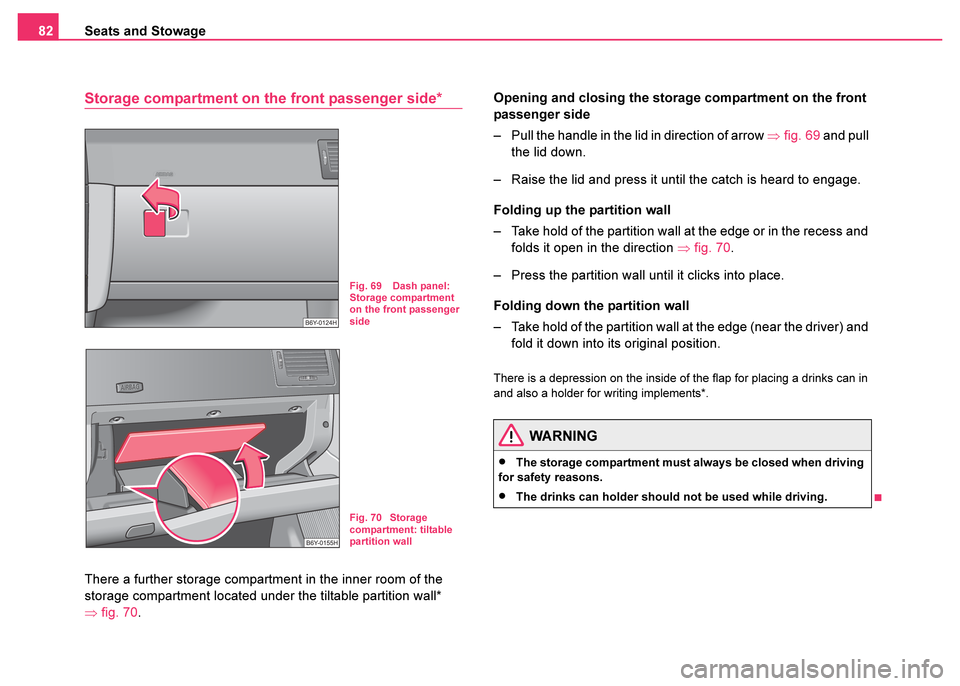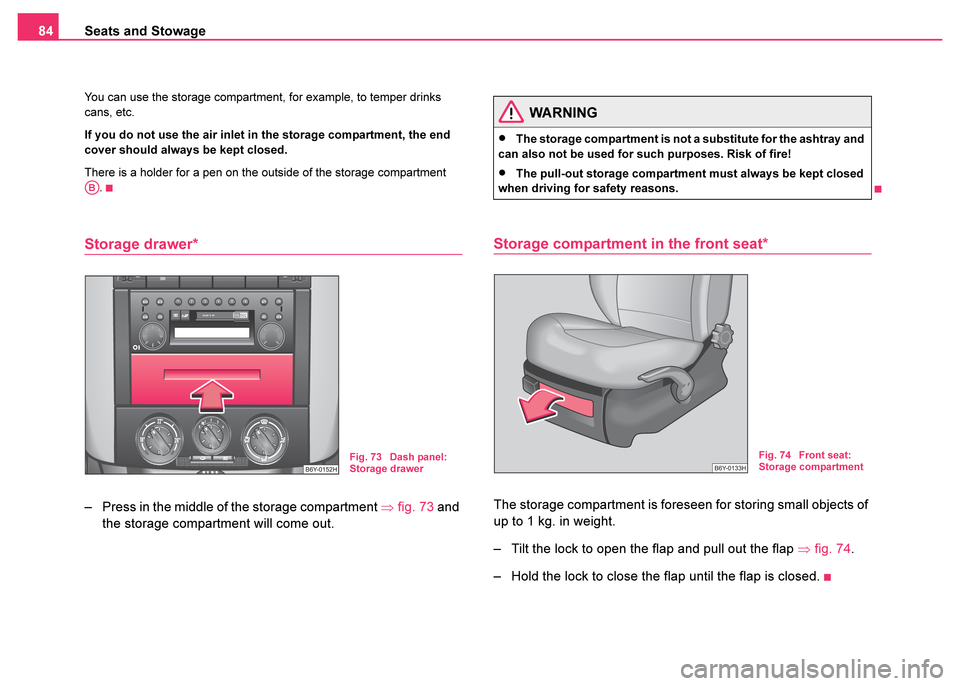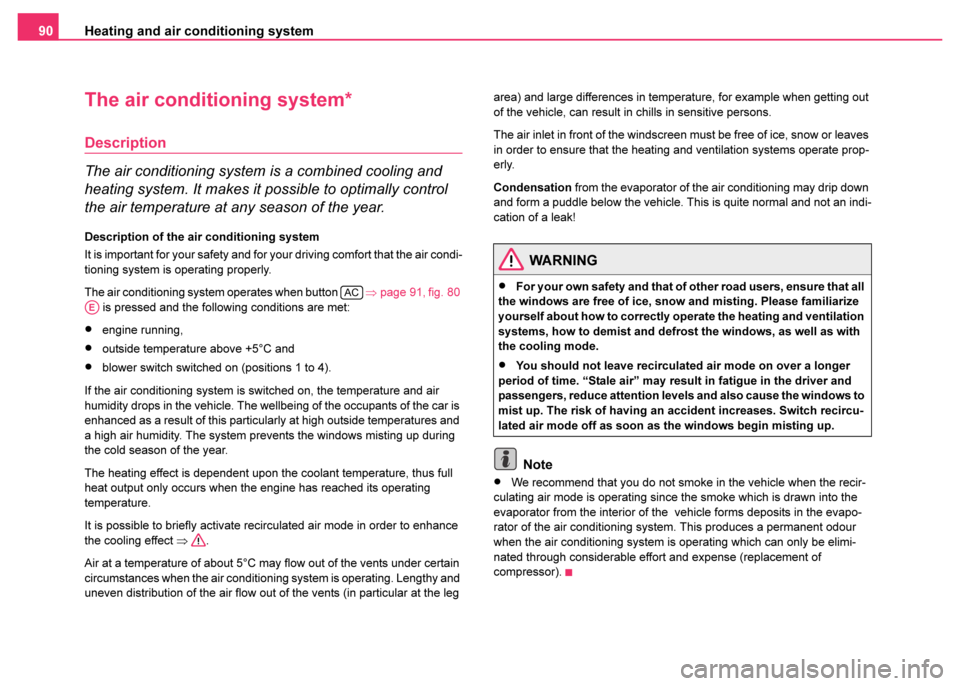2003 SKODA FABIA warning
[x] Cancel search: warningPage 83 of 233

Seats and Stowage
82
Storage compartment on the front passenger side*
There a further storage compartment in the inner room of the
storage compartment located under the tiltable partition wall*
⇒ fig. 70 . Opening and closing the storage compartment on the front
passenger side
– Pull the handle in the lid in direction of arrow
⇒fig. 69 and pull
the lid down.
– Raise the lid and press it until the catch is heard to engage.
Folding up the partition wall
– Take hold of the partition wall at the edge or in the recess and folds it open in the direction ⇒fig. 70 .
– Press the partition wall until it clicks into place.
Folding down the partition wall
– Take hold of the partition wall at the edge (near the driver) and fold it down into its original position.
There is a depression on the inside of the flap for placing a drinks can in
and also a holder for writing implements*.
Fig. 69 Dash panel:
Storage compartment
on the front passenger
side
Fig. 70 Storage
compartment: tiltable
partition wall
WARNING
•The storage compartment must always be closed when driving
for safety reasons.
•The drinks can holder should not be used while driving.
Page 85 of 233

Seats and Stowage
84
You can use the storage compartment, for example, to temper drinks
cans, etc.
If you do not use the air inlet in the storage compartment, the end
cover should always be kept closed.
There is a holder for a pen on the outside of the storage compartment
.
Storage drawer*
– Press in the middle of the storage compartment ⇒fig. 73 and
the storage compartment will come out.
Storage compartment in the front seat*
The storage compartment is foreseen for storing small objects of
up to 1 kg. in weight.
– Tilt the lock to open the flap and pull out the flap ⇒fig. 74 .
– Hold the lock to close the flap until the flap is closed.
AB
Fig. 73 Dash panel:
Storage drawer
WARNING
•The storage compartment is not a substitute for the ashtray and
can also not be used for such purposes. Risk of fire!
•The pull-out storage compartment must always be kept closed
when driving for safety reasons.
Fig. 74 Front seat:
Storage compartment
Page 89 of 233

Heating and air conditioning system
88
Note
•The whole heat output will be needed to unfrost the windscreen and
side windows. No warm air will be fed to the footwell. This can lead to
restriction of the heating comfort.
•The used air streams out through the air removal openings in the
luggage compartment.
Set heating
Recommended settings of heating controls for:
Defrosting the windscreen and side windows
•Turn control dial ⇒page 87, fig. 78 to the right up to the stop
•Control dial in the position 4
•Control dial in the position
•Open air outlet vents 4 ⇒ page 89, fig. 79 and point towards the side
window.
Keeping windscreen and side windows demisted
We recommend that you use the following setting in cases where the
windows are misted up more than usual (e.g. when it is raining):
•Control dial where necessary to the heating range
•Control dial in position 2 or 3
•Control dial to or as required or to any desired position
between these symbols
•Open air outlet vents 4 and point towards the side window
Warming up the inside of the vehicle as rapidly as possible
•Turn control dial to the right up to the stop
•Control dial in the position 4
•Control dial in the position
•Open the air outlet vents 4
•We recommend pressing button air recirculation mode. The
windows can steam up in this position however.
Heating the vehicle to a comfortable temperature
We recommend the following setting once the windows are no longer
misted up and the desired teperature has been reached:
•Control dial at the desired heat output
•Control dial in position 2 or 3
•Control dial in the position
•Open the air outlet vents 4
•Set the air distribution regulator as required between positions
and , if the windscreen gets misted up again.
Fresh air mode - ventilation
Non- pre-warmed fresh air streams through the air inlet nozzles 3 and 4
for the following settings.
Recirculated air mode must not be switched on.
•Turn the control dial ⇒ page 87, fig. 78 to the left up to the stop
•Control dial into the desired position
•Control dial in the position
•Open air outlet vents 3 and 4 ⇒page 89, fig. 79
WARNING
You should not leave recirculated air mode on over a longer period
of time. “Stale air” may result in fatigue in the driver and passen-
gers, reduce attention levels and also cause the windows to mist
up. The risk of having an accident increases. Switch recirculated
air mode off as soon as the windows begin misting up.
AA
AB
AC
AA
AB
AC
AA
AB
AC
AD
AA
AB
AC
AC
AA
AB
AC
Page 90 of 233

Heating and air conditioning system89
Using the systemSafetyDriving TipsGeneral MaintenanceBreakdown assist-
anceTechnical DataFabia Praktik
The control dial can be set to other positions as required.
Recirculated air mode
In recirculated air mode air is sucked out of the interior of
the vehicle and then fed back into the interior.
Recirculated air mode prevents po
lluted air outside the vehicle
from getting into the vehicle, for example when driving through a
tunnel or when standing in a traffic jam.
Switching recirculated air mode on
– Press button , the button symbol
lights up ⇒page 87,
fig. 78 .
Switching recirculated air mode off
– Press button again, the button symbol
goes out.
Recirculated air mode is switched off automatically if the air distribution
control is in position ⇒ page 87, fig. 78 ⇒page 87, fig. 78 .
Air outlet vents
Fig. 79 Air outlet vents
Warmed or unwarmed air will flow out of the air outlet vents according to
the setting of control dial ⇒page 87, fig. 78.
You can set the air supply to the individual air outlet vents using the control
dial .
Air outlet vents 3 and 4 can also be opened or closed individually:
•Air outlet vent fully open - knurled wheel vertically in position F
⇒ fig. 79
•Air outlet vent fully closed - knurled wheel vertically in position F or
G .
Turning the horizontal and vertical knurled wheels on the air outlet vents
3 and 4 allows one to change the direction of the inlet air flow .WARNING
•You should not leave recirculated air mode on over a longer
period of time. “Stale air” may result in fatigue in the driver and
passengers, reduce attention levels and also cause the windows to
mist up. The risk of having an accident increases. Switch recircu-
lated air mode off as soon as the windows begin misting up.
AC
AC
AA
AC
Page 91 of 233

Heating and air conditioning system
90
The air conditioning system*
Description
The air conditioning system is a combined cooling and
heating system. It makes it possible to optimally control
the air temperature at any season of the year.
Description of the air conditioning system
It is important for your safety and for your driving comfort that the air condi-
tioning system is operating properly.
The air conditioning system operates when button ⇒page 91, fig. 80
is pressed and the following conditions are met:
•engine running,
•outside temperature above +5°C and
•blower switch switched on (positions 1 to 4).
If the air conditioning system is switched on, the temperature and air
humidity drops in the vehicle. The wellbeing of the occupants of the car is
enhanced as a result of this particularly at high outside temperatures and
a high air humidity. The system prevents the windows misting up during
the cold season of the year.
The heating effect is dependent upon the coolant temperature, thus full
heat output only occurs when the engine has reached its operating
temperature.
It is possible to briefly activate recirculated air mode in order to enhance
the cooling effect ⇒.
Air at a temperature of about 5°C may flow out of the vents under certain
circumstances when the air conditioning system is operating. Lengthy and
uneven distribution of the air flow out of the vents (in particular at the leg area) and large differences in temperature, for example when getting out
of the vehicle, can result in chills in sensitive persons.
The air inlet in front of the windscreen must be free of ice, snow or leaves
in order to ensure that the heating and ventilation systems operate prop-
erly.
Condensation from the evaporator of the air conditioning may drip down
and form a puddle below the vehicle. This is quite normal and not an indi-
cation of a leak!
Note
•We recommend that you do not smoke in the vehicle when the recir-
culating air mode is operating since the smoke which is drawn into the
evaporator from the interior of the vehicle forms deposits in the evapo-
rator of the air conditioning system. This produces a permanent odour
when the air conditioning system is operating which can only be elimi-
nated through considerable effort and expense (replacement of
compressor).
ACAE
WARNING
•For your own safety and that of other road users, ensure that all
the windows are free of ice, snow and misting. Please familiarize
yourself about how to correctly operate the heating and ventilation
systems, how to demist and defrost the windows, as well as with
the cooling mode.
•You should not leave recirculated air mode on over a longer
period of time. “Stale air” may result in fatigue in the driver and
passengers, reduce attention levels and also cause the windows to
mist up. The risk of having an accident increases. Switch recircu-
lated air mode off as soon as the windows begin misting up.
Page 94 of 233

Heating and air conditioning system93
Using the systemSafetyDriving TipsGeneral MaintenanceBreakdown assist-
anceTechnical DataFabia Praktik
Fresh air mode - ventilation
Non- pre-warmed fresh air streams through the air inlet nozzles
3 and 4
for the following settings.
•Turn the control dial ⇒page 91, fig. 80 to the left up to the stop
•Control dial into the desired position
•Control dial in the position
•Open air outlet vents 3 and 4 ⇒ fig. 81
•Switch off the recirculated air mode by pressing button .
•Switch off the cooling by pressing button
The control dial can be set to other positions as required.
Recirculated air mode
In recirculated air mode air is sucked out of the interior of
the vehicle and then fed back into the interior.
Recirculated air mode prevents po lluted air outside the vehicle
from getting into the vehicle, for example when driving through a
tunnel or when standing in a traffic jam.
Switching recirculated air mode on
– Press button ⇒page 91, fig. 80 , the button symbol
lights up.
Switching recirculated air mode off
– Press button again, the button symbol
goes out.
Recirculated air mode is switched off automatically if the air distribution
control is in position ⇒ page 91, fig. 80 . You can also switch recir- culated air mode on again from this setting by repeatedly pressing button
.
Air outlet vents
Fig. 81 Air outlet vents
Unwarmed or cooled air will flow out of the air outlet vents according to the
setting of control dial ⇒page 91, fig. 80 and the atmospheric condi-
tions.
AA
AB
AC
AD
AE
AC
AC
WARNING
You should not leave recirculated air mode on over a longer period
of time. “Stale air” may result in fatigue in the driver and passen-
gers, reduce attention levels and also cause the windows to mist
up. The risk of having an accident increases. Switch recirculated
air mode off as soon as the windows begin misting up.
AD
AA
Page 96 of 233

Starting-off and Driving95
Using the systemSafetyDriving TipsGeneral MaintenanceBreakdown assist-
anceTechnical DataFabia Praktik
Starting-off and Driving
Setting steering wheel position*
You can set the height and the forward/back position of the
steering wheel to the desired position.
– Adjust the driver seat ⇒page 63.
– Pull the lever below the steering column ⇒fig. 82 down
⇒ .
– Set the steering wheel to the desired position (concerning height and forward/back position).
– Then push the lever up against the steering column until it locks into place.
Ignition lock
Petrol engines
- ignition switched off, engine off
- ignition switched on
Fig. 82 Adjustable
steering wheel: Lever
below steering column
WARNING
•Only adjust the steering wheel when the car is stationary!
•For safety reasons the lever must always be firmly pushed up
to avoid the steering wheel altering its position unintentionally
when driving - risk of accident!
Fig. 83 Ignition lock
positions
A1
A2
Page 97 of 233

Starting-off and Driving
96
- start engine
Diesel engines - fuel supply interrupted, ignition switched off, engine off
- heating glow plugs on, ignition switched on
•You should not switch on any major electrical components during the
heating period otherwise the vehicle battery will be drained unnecessarily.
- start engine
Applies to all models:
Position
To lock the steering , with the ignition key withdrawn, turn the steering
wheel until the steering locking pin is heard to engage. You should always
lock the steering as a general rule if you leave your vehicle. This acts as
a deterrent against possible theft of your vehicle ⇒.
Position
Move the steering wheel back and forward a little if the ignition key cannot,
or cannot easily be turned into this position, in order to release the
steering lock.
Position
The engine is started in this position. At the same time switched on low
beam or main beam or other electrical components with major power
consumption are briefly switched off. The ignition key moves back into
position when one releases the key.
The ignition key must be turned back into position each time before
starting the engine again. The starter repeat lock in the ignition lock
prevents the starter being engaged when the engine is running and thus
getting damaged. Ignition key withdrawal lock (automatic gearbox)
You can only withdraw the ignition key after switching off the ignition if the
selector lever is in position
P.
Starting engine
General
You can only start the engine only using an original ignition
key.
•Place the gearshift lever into neutral (or place the selector lever to the
position P or N in the case of an automatic gearbox) and put on the hand-
brake firmly before starting the engine.
A3
A1
A2
A3
A1
A2
A3
A2
A1
WARNING
•When driving, the ignition key must always be in the position
(ignition switched on) without the engine running. This position is
indicated by the warning lights coming on. If this is not the case, it
could result in unexpected locking of the steering wheel - risk of
accident!
•Only remove the ignition key from the ignition lock when the
vehicle has come to a standstill (put on the handbrake or select the
selector lever position P). The steering lock might otherwise
engage unintentionally - risk of accident!
•Always withdraw the ignition key if you are going to leave the
vehicle, even for a short time. This is particularly important if chil-
dren are left in the vehicle. The children might otherwise start the
engine or operate electrical equipment (e.g. power windows) - risk
of injury!
A2